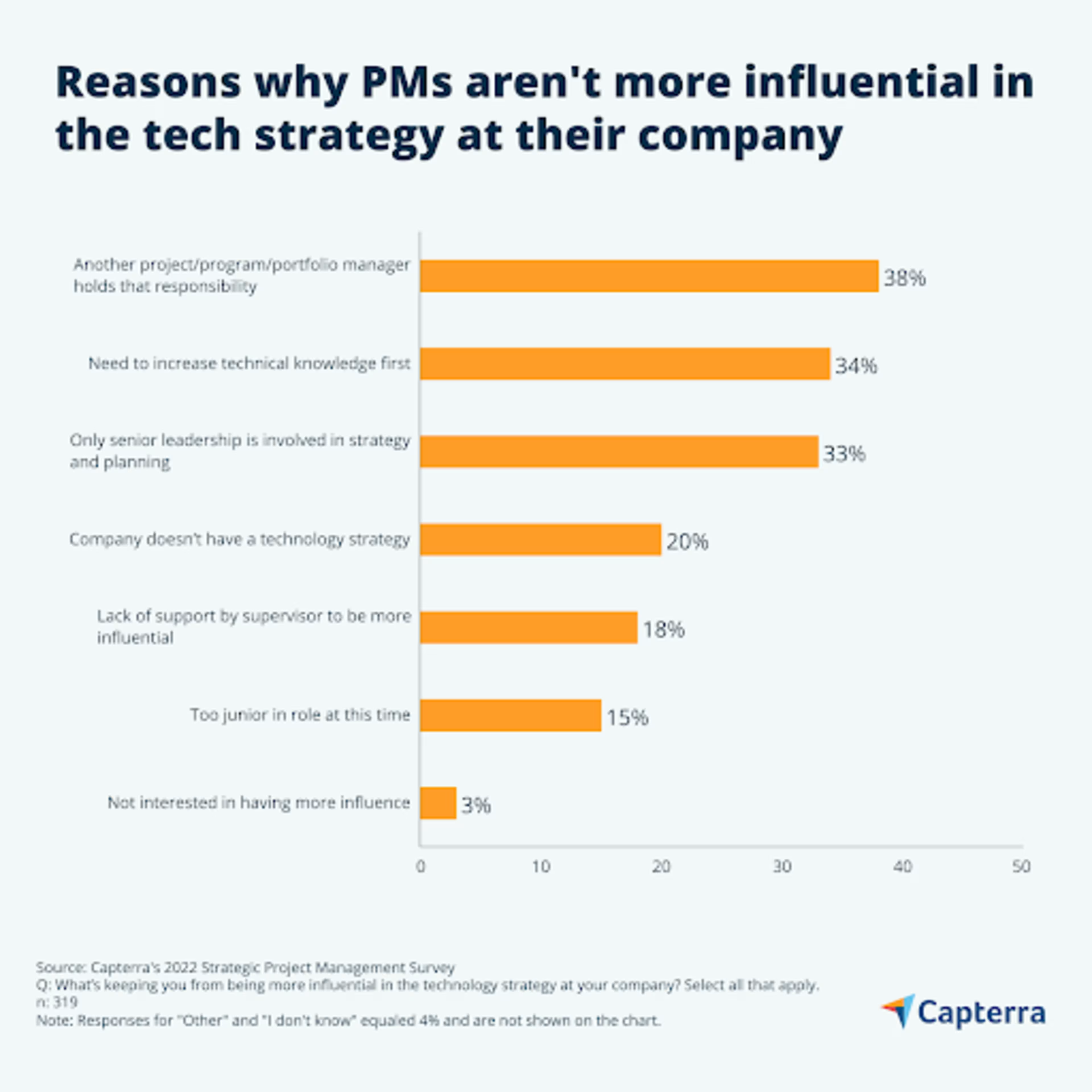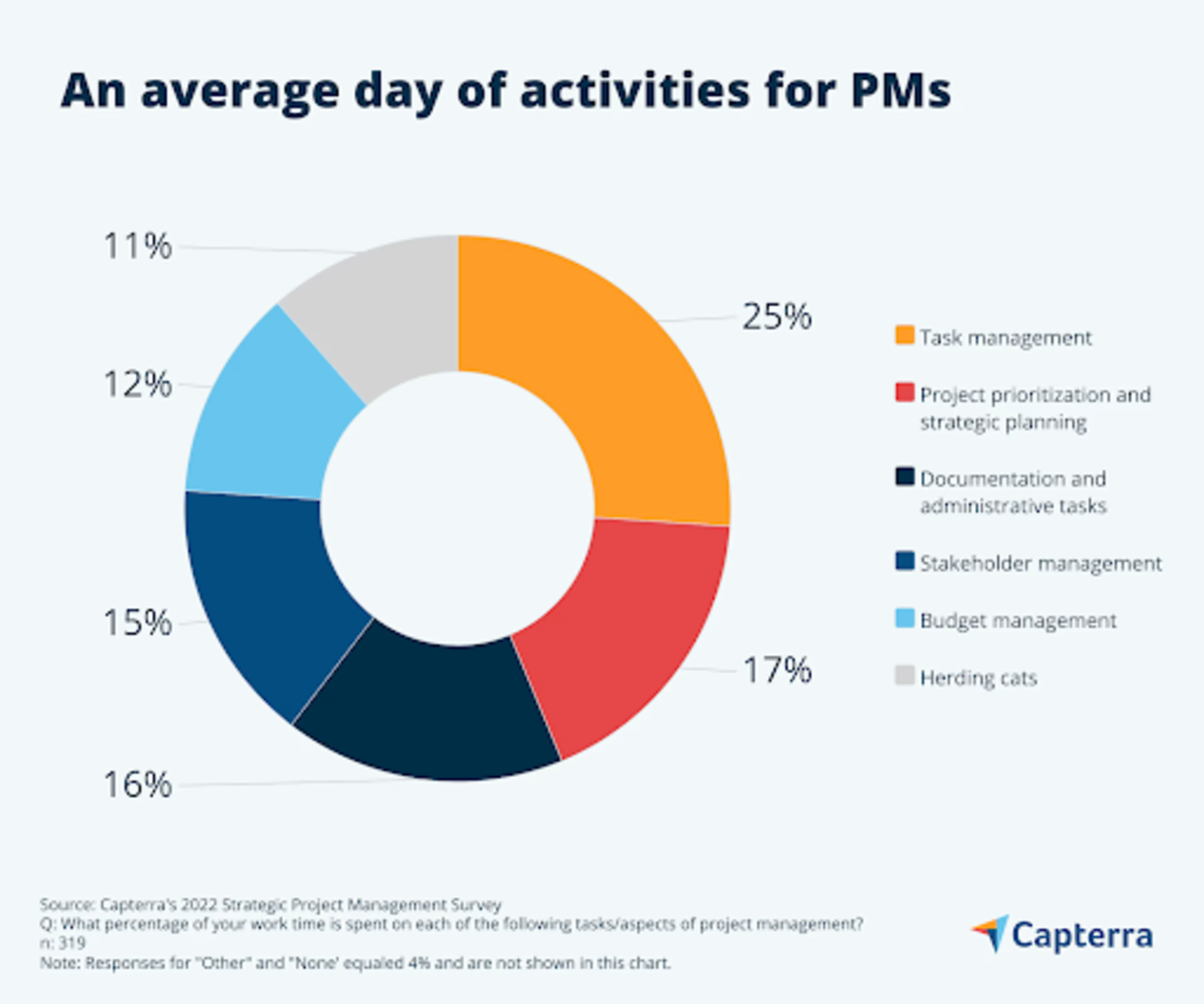Less than half of PMs surveyed report having influence in the technology strategy of their company.
An IT tech strategy is a vital part of a company's backbone, but over half of PMs say they aren't involved in the strategic planning or decision-making for IT goals. Because PMs know the operational side of things and understand the IT capabilities and limitations, it's wise to have them involved.
But as a PM that wants to become more influential in tech strategies, you know that the average PM spends less than a fifth of their day on high-level project planning and strategic planning, and THAT time is split between leading an active project at a high-level and planning for future projects. So how do you become more influential in your company’s tech strategy, and how do you even find time to do it?
To learn why PMs aren’t more influential and what should be done to get them more involved in their company’s tech strategy, we conducted the Strategic Project Management Survey [*] in September 2022 of 319 project managers.
Project managers can use data from this study to gauge their level of influence against that of their peers, as well as to increase their influence in organizational technology strategy.
Business leaders can use this data to leverage their project managers’ expertise to support and advance their tech strategy.
Key highlights
On average, a PM spends over 40% of their day on task management and administrative tasks.
Seventeen percent of their time goes to high-level project prioritization and strategic planning.
Thirty-four percent report needing to increase their technical knowledge first before they can become more influential in the tech strategy at their company.
Eighty-seven percent agree that they could have a greater impact on the quality and effectiveness of their company’s technology strategy if leadership would allow them to be more involved.
What is a technology strategy?
A technology strategy is the defined plan that the IT department will use to guide the implementation, maintenance, and advancement of how technology is used within their company in order to best achieve business objectives. From “keeping the lights on” to driving the competitive edge of the company, IT is vital for a company to be able to achieve mission-critical goals.
Areas covered typically include rules and guidance for:
Analytics and reporting
Infrastructure architectural design
Data management processes, including audit trails and key performance indicator (KPI) calculations
Cybersecurity protocols
Governance and steering committee members and guidelines
IT asset management and disposition
Risk management plan, including disaster recovery
Implementation methods, such as the development approach and project management methodology
As you can see from this list, the tech strategy isn’t just a list of technology choices, but also includes processes, design philosophy, and team/cultural elements. Typically the development of your tech strategy requires the involvement of not only the head of IT and their leads of each area covered, but also senior business leaders in order to ensure the plan is thorough, thoughtful, and has the full support from senior executives.
Now let’s get into how project managers are involved in setting and executing the tech strategy.
Less than half of PMs are highly influential in determining the business need for projects
Project managers sit between operations, aka “the business,” and IT and are ideally included in the discussions around determining the business need and project goals for an IT project. This position allows them to learn about operational issues and challenges in ways other IT resources aren’t typically exposed to, making PMs an ideal partner to develop and execute the tech strategy.
But not all companies realize the capabilities of an informed and empowered project manager and don’t include them in higher-level strategy planning meetings. In fact, 87% of project managers surveyed agree that they could have a greater impact on the quality and effectiveness of their company’s technology strategy if leadership would allow them to be more involved.
Let’s take a look at exactly how PMs are involved in the tech strategy and the reasons for not being more influential. We asked project managers about their level of involvement in and areas of influence around the planning and executing of the technology strategy used in their companies.

We expected to see PMs being less influential in areas such as making the final decision and approving technology purchases, as these decisions are usually made by the CTO/CIO or other IT department heads. But we are surprised to see fewer than half of PMs (47%) report being influential in determining the business need in the tech strategy. While a project manager wouldn’t be the sole owner of this aspect (actually no single person should be responsible for any one aspect), they should be highly involved in and driving the conversation around how IT can best support the business’s needs.
As the business owner for each project must be an operational leader and should be working closely with the PM, over time the PM will gain a considerable amount of operational knowledge—more than most any other IT resource. And this makes them ideal partners to help identify areas of risk and where IT can best drive operational goals.
So what’s keeping PMs from being more influential? In the next section, we’ll cover just that and give recommendations on what you can do if you’re experiencing similar blockers.
What you can do to become more influential, by situation
The reasons why PMs aren’t more influential in the technology strategy at their companies tend to be external factors, or ones they can’t immediately change. In fact, three of the top four reasons reported in our survey are company-culture based, and therefore will require a long-term approach to make progress. Here’s the breakdown of the top reasons:

Let’s dive into the top three reasons for why project managers aren’t more influential and give some tips for what you can do about it.
If another project manager holds the responsibility:
Over one-third of PMs (38%) report that another project manager (or program/portfolio manager) holds the role of influencing the tech strategy on behalf of the other project managers. And it’s common for the most senior PM to be the one included in the high-level planning and strategizing and to be the representative for your team/interests, but this shouldn’t stop you from developing a strong relationship with them so you can learn from them.
If you don’t already have a close relationship, then reach out and ask to schedule time to get to know them better. Be frank about why you’re reaching out, telling them you admire where they’re at in their career. They may even offer to be your mentor!
If you need to increase your technical knowledge first:
Thirty-four percent of PMs report needing to deepen their understanding of the technical IT aspects before they become more influential in the tech strategy. The solution here is to focus on education and exposure, and we recommend taking a two-prong approach:
Look for resources available to you within your company, including learning from people such as the IT architect and taking any training offered through your HR or training departments.
For instance, you can reach out to the IT director and ask if you could join their team meetings just to learn more about the issues, tasks, projects, and collaboration style the technical teams have. It’s a great way to pick up on the jargon used in your company as well.
Take classes or attend training from professional development organizations on IT infrastructure best practices and other technical knowledge areas. Most online education companies offer courses on the topic. And while they’ll likely be designed for software programmers or people looking to become a systems architect, the intro courses will be a great place for you too.
If only senior leadership is involved in strategy and planning:
Thirty-three percent of project managers say that only senior leaders manage the tech strategy and that their participation is limited due to this philosophy. This scenario will require more patience on your part as leadership tends to be slow to make changes to their management style.
A first step you should take is to get creative in ways to get closer to the senior leadership team, perhaps by offering to take notes during their IT strategy and planning meetings or putting together the proposals or other documentation they review in such meetings. This way you’ll learn about the issues they’re facing, build rapport with them, and expand your knowledge of the business. But be sure to talk with your manager first as you don’t want to overstep any boundaries.
These approaches also work for the 20% of PMs who say their company doesn’t currently have a tech strategy and for the 15% of PMs who report being too junior in their role at this time to be more influential. We recommend focusing on your project work and building the foundational skills now so you’ll be ready to take on more responsibility when the time is right.
Next, let’s take a look at the average day of a PM and learn about how you can make progress from being a task manager to a strategic partner.
How to make more time for high-level, strategic work
So now that you have ideas on what to do to become a more influential PM, you probably need more time in your day to actually do that work. But where does this time come from? Let’s first look where a project manager is spending their time and then get into where and how to make changes. We asked survey respondents what percent of their day is dedicated to a list of the main activities a PM is responsible for and then used the average of all responses for the chart below.

Overall, a PM’s day on average is fairly well balanced, but these results do show some areas for improvement. Specifically, the 41% of their day that is dedicated to task management and administrative tasks that can be trimmed down to free up time for building strategic relationships and deepening technical knowledge. Let’s take a look at exactly what this looks like.
What you can do
Delegation of tasks and leveraging software automation are two top ways to reduce your time spent on administrative duties and task management.
Delegation: This doesn’t only mean assigning your work to other people. In project management, delegation can often mean working with your project team to identify small changes they can make that will help speed up the status update process or documentation process, among others. Perhaps you can add fields to the task in your software system for some of the information you often have trouble getting from the team, such as the amount of hours spent on a particular task.
When asking your team to change or increase the amount of time they’re spending on administrative tasks, it’s important to share with them exactly why you’re asking this from them. Be open with them about the struggles you’re having and how what you’re asking them to do helps.
Software automation: Save time and improve the accuracy of your status reports, progress tracking, and budgeting by using the automation features in a project management tool. For example, for budget tracking, you may have to contact each resource every week to understand how many hours they spent on your project and then you manually calculate the actual spend for your weekly status reports. This approach is error prone and time consuming.
Instead, see if the task tracking tool you already use has a feature for time tracking where everyone enters their hours in their ticket, and then the system can generate the budget status update for you. Most project management tools even generate the entire status report for you.
If you’re looking for a new project management system, but you’re not sure where to start, we’ve created a PM Software Buyers Guide to help. Here you’ll learn about the benefits, features, and general pricing information of a project management tool.
If you’re looking for a new project management system, but you’re not sure where to start, we’ve created a PM Software Buyers Guide to help. Here you’ll learn about the benefits, features, and general pricing information of a project management tool.
Using these two tactics and the recommendations we’ve shared throughout this report can reduce the amount of time you’re spending on task management, administrative tasks, and herding cats to free up about 20% of your day to spend on becoming more influential. We recommend spending this time:
Shadowing more senior PMs to learn from them.
Learning about the technical environment and design philosophy of your company’s tech strategy.
Building relationships with business leaders to be seen as a reliable go-to resource for when strategic planning meetings are scheduled so you can score an invite.
